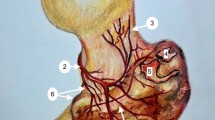Abstract
Background
Proximal femoral physeal fractures are rare in abused children. Recognition may be hampered due to their rarity and lack of an ossified femoral head. Prompt diagnosis and treatment are essential to preventing coxa vara.
Objective
To demonstrate the radiographic features of proximal femoral physeal fractures both with unossified and ossified femoral heads.
Materials and methods
We reviewed our Institutional Review Board-approved 21-year radiology database of 2,206 children who had a skeletal survey as part of their medical evaluation for possible abuse. Cases of proximal femoral physeal fractures were identified.
Results
Eight patients, ages 2.5 to 26 months, with 10 fractures were found, yielding a prevalence of 0.4% (8/2,206). In all fractures, there was lateral displacement of the proximal femur. In three fractures, the femoral head was not ossified, simulating a hip dislocation. The intra-articular location of the femoral head was verified by ultrasound or abdomen computed tomography. Subperiosteal new bone formation was present in six fractures, all non-weight-bearing patients. The femoral head was ossified in seven cases, all with medial rotation of the femoral head. Metaphyseal irregularity was present in three of four fractures of the weight-bearing patients; two of three also had metaphyseal scalloping resembling osteomyelitis. The three with metaphyseal irregularity developed coxa vara.
Conclusion
Proximal femoral physeal fractures are rare in abuse cases. All present with lateral displacement of the proximal femur. With an unossified femoral head, it can simulate hip dislocation, which can be clarified with hip sonogram. Metaphyseal irregularity appears to be a feature in weight-bearing patients.








Similar content being viewed by others
References
Boardman MJ, Herman MJ, Buck B, Pizzutillo PD (2009) Hip fractures in children. J Am Acad Orthop Surg 17:162–173
Theodorou SD, Ierodiaconou MN, Mitsou A (1982) Obstetrical fracture-separation of the upper femoral physis. Acta Orthop Scand 53:239–243
Beals RK, Tufts E (1983) Fractured femur in infancy: the role of child abuse. J Pediatr Orthop 3:583–586
Azouz EM, Karamitsos C, Reed MH et al (1993) Types and complications of femoral neck fractures in children. Pediatr Radiol 23:415–420
Ogden JA, Lee KE, Rudicel SA, Pelker RR (1984) Proximal femoral epiphysiolysis in the neonate. J Pediatr Orthop 4:285–292
Caterini R, Farsetti P, d’Arrigo C, Ippolito E (1991) Unusual physeal lesions of the lower limb. A report of 16 cases with very long-term follow-up observation. J Orthop Trauma 5:38–46
Blockey NJ (1969) Observations of infantile coxa vara. J Bone Joint Surg Br 51:106–111
Jones JC, Feldman KW, Bruckner JD (2004) Child abuse in infants with proximal physeal injuries of the femur. Pediatr Emerg Care 20:157–161
Paris N, Journeau P, Moh Ello N et al (2008) Bilateral upper femoral physis injury in a case of epilepsy in a young child. Rev Chir Orthop Reparatrice Appar Mot 94:403–406
Kleinman PK (2015) Diagnostic imaging of child abuse. United Kingdom, Cambridge
Dwek JR (2010) The periosteum: what is it, where is it, and what mimics it in its absence? Skeletal Radiol 39:319–323
Author information
Authors and Affiliations
Corresponding author
Ethics declarations
Conflicts of interest
None
Additional information
Publisher’s note
Springer Nature remains neutral with regard to jurisdictional claims in published maps and institutional affiliations.
Rights and permissions
About this article
Cite this article
Shalaby-Rana, E., Hinds, T.S., Deye, K. et al. Proximal femoral physeal fractures in children: a rare abusive injury. Pediatr Radiol 50, 1115–1122 (2020). https://doi.org/10.1007/s00247-020-04669-2
Received:
Revised:
Accepted:
Published:
Issue Date:
DOI: https://doi.org/10.1007/s00247-020-04669-2




